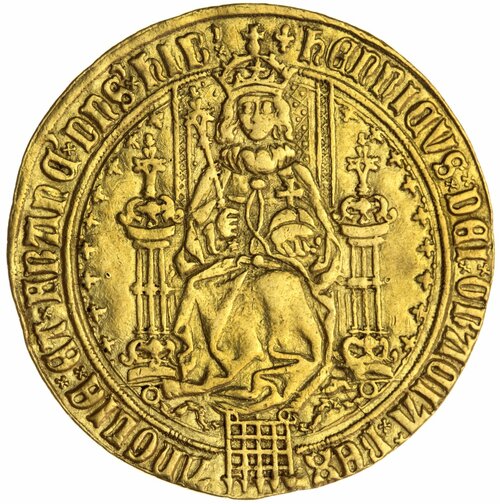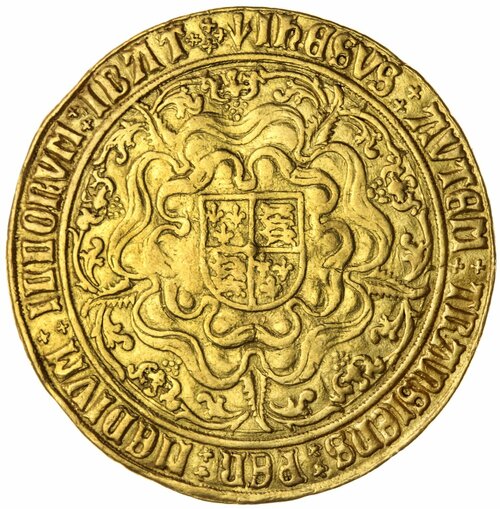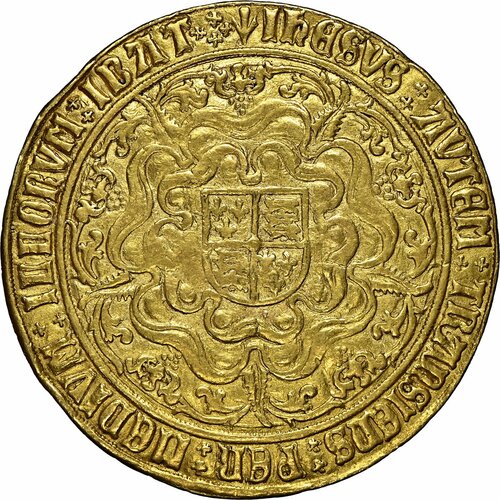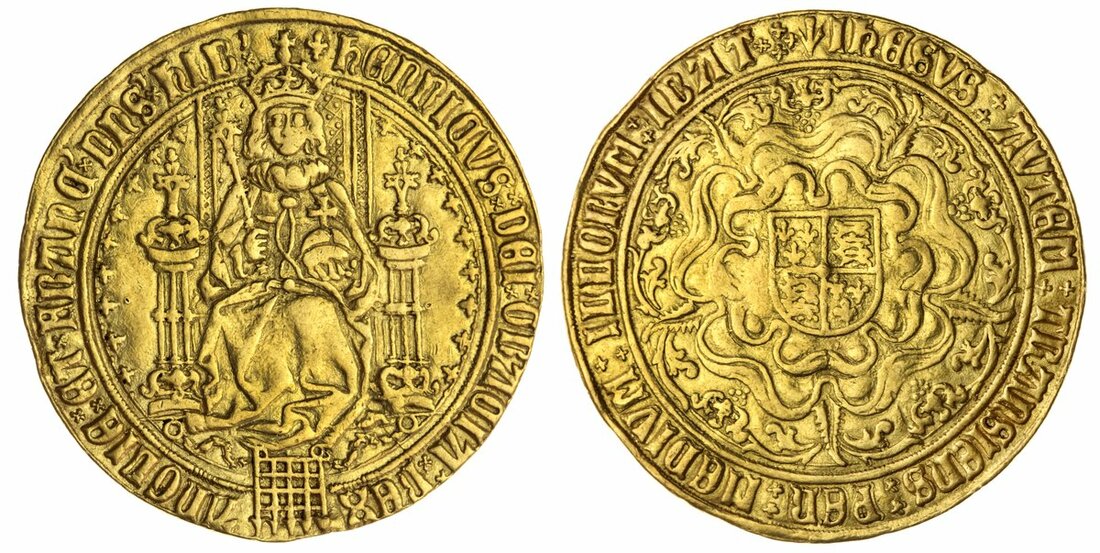Auction: 21064 - The Horace Hird Collection of Tudor, Stuart and Commonwealth Coins and Patterns
Lot: 42
XF40 | Henry VII (1485-1509), 'Double Ryal' or Sovereign [of 20-Shillings], Type Vb, (1 December 1505 - April 1509), Tower, (m.m.) hEnRICVS : DEI : GRACIA : REX | AnGLIE : ET : FRANC •' DnS •' hIB •' double saltire stops, King seated on narrow throne simplistically ornamented with fine latice work and pellet backing, holding orb and sceptre, flanked by pillars, portcullis below, rev. (m.m.) ihESVS : AVTEM : TRAnSIEnS : PER : MEDIVM : ILLORVM : IBAT •:•, crosslet stops with four at terminus of legend, Royal shield set on Tudor Rose inside ornate floral tressure with 'bunches of grapes' terminals, spandrels otherwise plain, 15.24g [235.1grns], 8h, m.m. Lis II/pheon (HCN 339; Murdoch III, 706 [Henry VIII, 238.5grns]; Murdoch I, 407 [Henry VIII, 235.5grns]; Rashleigh -; Brooke IVc = BM 1935.0401.817 same dies; BM 1866.0713.1 = Carlyon-Britton [1925], pp. and Pl. V, no. 82 same dies; Potter & Winstanley Vb = Lockett 4039 this coin mentioned; SCBI Ashmolean 83, same dies; Schneider I, 551/- same obverse die, but the rev. m.m. unrepresented; North 1692/2; Spink 2176), on a slightly concave and bright flan, otherwise a pleasingly uniform and broad strike, near very fine, extremely rare with only six examples known to Potter and Winstanley, two of those in Museums; yet the National Collection not acquiring a comparative example until 1935, and only the Dr Carter example resurfacing in recent commerce, in NGC 'Horace Hird' holder, graded XF40 (Cert. #6135299-042)
Provenance
A Lost Parcel from the Celebrated Horace Hird Collection
Lockett, Part IV, Glendining, 26-27 April 1960, lot 4039 [illus.] - very fine and very rare - £680.0.0
J Pierpont-Morgan, collection part-purchased by Lockett, 1915
Sir John Evans, collection purchased by J Pierpont-Morgan, 1909
Only one pair of dies is known for this issue, severally used for the production of cross-crosslet reverses previously as well as the famed Double-Sovereigns. Only three examples of this latter piedfort coinage are known, with only one example recorded with the Pheon reverse acquired in 1866 from dealer George Eastwood for the National Collection for the princely sum of £100.0.0 (BM 1866.0713.1).
Confounding matters is the attribution of this issue by Kenyon to the Second Coinage of Henry VIII, consequently explaining its mis-identification in the important Montagu and Murdoch sale catalogues amongst many others. L A Lawrence, a self-confessed 25-year student of the Henry VII coinage on account of its 'pleasure and satisfaction from whatever point of view', successfully argued (NumChron, Series IV, Vol. XVIII [1918], pp. 205-261), for their reattribution to the last phase of the Winter King. He added: 'Mr. Symonds has already referred to the rarity of Henry VII Sovereigns and has suggested one probable cause in the remelting of thse heavy pieces to produce the later debased gold of Henry VIII's (see next lots) coins towards the end of his reign. The order, however, only allowed two sovereigns in each pound weight to be made, so that under no circumstances could these coins ever have been common. I have never heard of a hoard in which any of them have been present.' [pp. 236]
Raymond Carlyon-Britton furthered the argument (BNJ, 1925, pp.1-62F and Pl. I-VIII), '....Kenyon incorrectly attributes them to Henry VIII....On the reverse dies of Henry VIII's sovereigns, lys, lions and saltires occur around the expanded rose; on those of Henry VII they are absent in the later sovereigns. The rose on Henry VIII's coins is surrounded by a well marked tressure....the later sovereigns of Henry VII have no well-defined tressure, and the alternate cusps, if they may be called such, terminate in what appear to be bunches of grapes.'
Subject to 20% VAT on Buyer’s Premium. For more information please view Terms and Conditions for Buyers.
Sold for
£130,000
Starting price
£15000













